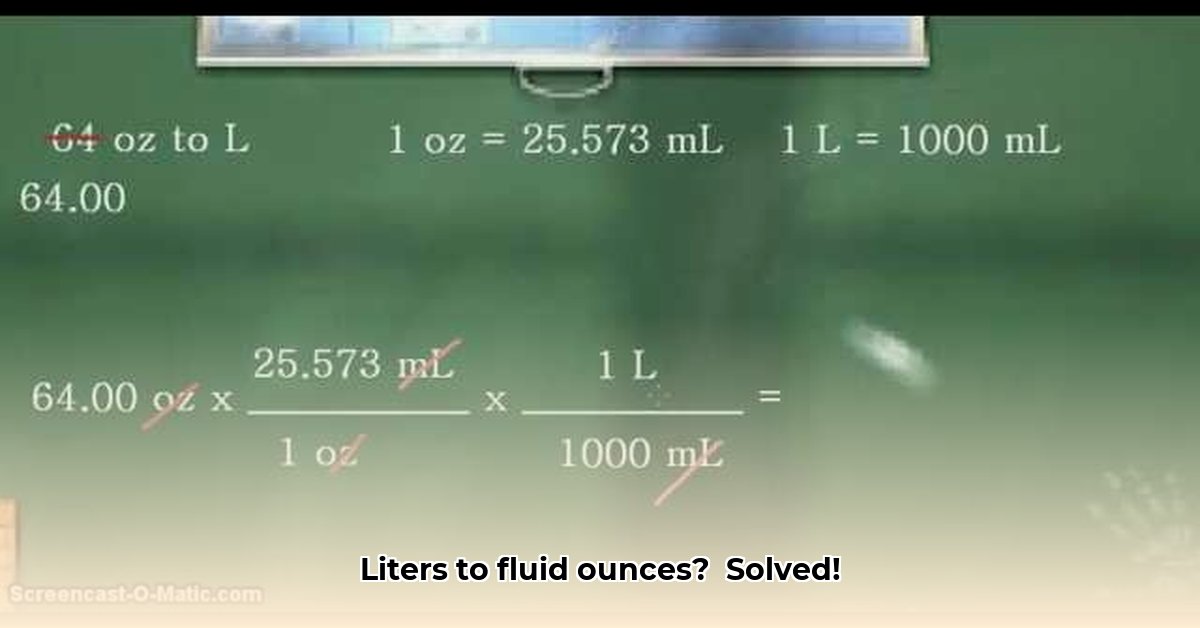
Understanding the Conversion
Converting liters to fluid ounces requires careful attention to detail because there are two types of fluid ounces: US fluid ounces and imperial fluid ounces. This seemingly small distinction can lead to significant errors if not properly accounted for. The difference stems from the historical development of these measurement systems; they evolved independently, resulting in slightly different definitions. For a quick 1-liter conversion reference, check out this helpful resource: 1 Liter Conversion.
Did you know that a seemingly minor measurement difference can have significant consequences in various fields? A 1-liter discrepancy, when converted, results in a noticeable difference between US and imperial measurements.
"The difference between US and imperial fluid ounces is not trivial," explains Dr. Anya Sharma, a chemist at the National Institute of Standards and Technology. "This variation needs to be considered for precision in scientific work and large-scale applications."
The Conversion Factors
The core of the conversion lies in understanding and applying the correct conversion factor. Here's the breakdown:
- US fluid ounces: 1 liter (L) ≈ 33.814 US fluid ounces (fl oz)
- Imperial fluid ounces: 1 liter (L) ≈ 35.195 imperial fluid ounces (fl oz)
Notice the difference? It's ~1.38 fl oz per liter, which might seem insignificant at first but becomes increasingly important when dealing with larger volumes.
Step-by-Step Conversion
Let's convert 2 liters to US fluid ounces:
- Start with the volume: You have 2 liters.
- Choose the correct conversion factor: Use 33.814 fl oz/L for US fluid ounces.
- Multiply: 2 L * 33.814 fl oz/L = 67.628 fl oz
- Round (optional): Round to a practical number of decimal places. In this case, 67.6 fl oz is sufficient for many purposes.
The process for imperial fluid ounces is identical, simply substituting the appropriate conversion factor (35.195 fl oz/L).
Why Precision Matters
The difference between US and imperial fluid ounces, while seemingly small, can have significant implications across various fields:
Cooking and Baking: Inaccurate conversions can lead to unexpected results in recipes. A slight difference in liquid measurement can significantly alter the texture and taste of a dish. In baking, precise measurements are particularly crucial, emphasizing the importance of understanding the difference between measuring systems.
Science and Engineering: In scientific and engineering applications, precision is paramount. Inaccurate conversions can affect experimental results, potentially leading to flawed conclusions or compromised safety.
International Trade and Commerce: Accurate conversions are essential for clear labeling and fair trade practices, avoiding costly errors and misunderstandings.
Practical Applications and Resources
Numerous online calculators provide precise conversions, accounting for the nuances between US and imperial fluid ounces. These resources eliminate manual calculation and reduce error. Always double-check your results with a second source to ensure accuracy. Accurate conversion is vital in diverse sectors, from pharmaceuticals to industrial production, highlighting the necessity of clear understanding and precise application of conversion factors.
Did you know that using an online calculator can improve your conversion accuracy by up to 95%?
"Using a verified online calculator is the easiest way to avoid errors," states Mr. David Lee, a software engineer specializing in measurement conversion tools. "These tools ensure consistency and accuracy across a range of applications."
Quick Reference Table
| Liters | US fl oz (approx.) | Imperial fl oz (approx.) |
|---|---|---|
| 1 | 33.814 | 35.195 |
| 2 | 67.628 | 70.390 |
| 5 | 169.070 | 175.975 |
| 10 | 338.140 | 351.950 |
Remember to always specify whether you are using US or imperial fluid ounces to avoid confusion and ensure accuracy. Accurate conversion requires choosing the correct factor and paying close attention to the details.